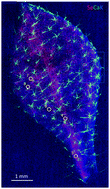当前位置:
X-MOL 学术
›
Metallomics
›
论文详情
Our official English website, www.x-mol.net, welcomes your feedback! (Note: you will need to create a separate account there.)
Identification and physiological comparison of plant species that show positive or negative co-occurrence with selenium hyperaccumulators.
Metallomics ( IF 3.4 ) Pub Date : 2020-01-29 , DOI: 10.1039/c9mt00217k R Jason B Reynolds 1 , Rachel R Jones , Gavin C Stonehouse , Ali F El Mehdawi , Leonardo W Lima , Sirine C Fakra , Elizabeth A H Pilon-Smits
Metallomics ( IF 3.4 ) Pub Date : 2020-01-29 , DOI: 10.1039/c9mt00217k R Jason B Reynolds 1 , Rachel R Jones , Gavin C Stonehouse , Ali F El Mehdawi , Leonardo W Lima , Sirine C Fakra , Elizabeth A H Pilon-Smits
Affiliation

|
In these studies we identified and compared the properties of plant species that showed positive or negative co-occurrence with selenium (Se) hyperaccumulators in their natural habitat. The main questions addressed were: which species are most abundant directly adjacent to hyperaccumulators, and which are absent? How do Se accumulation and tolerance compare in species found to positively or negatively co-occur with hyperaccumulators? Approaches included field surveys, X-ray microprobe analysis of field samples, and a lab Se tolerance and accumulation study. When 54 hyperaccumulators across two naturally seleniferous sites were surveyed for their five nearest neighboring species, and the relative abundance of these species around hyperaccumulators compared to that in the overall vegetation, some species were identified to positively or negatively co-occur with hyperaccumulators. Several positively co-occurring species showed high Se accumulation capability (up to 900 mg Se per kg dry weight), which may reflect Se tolerance. Leaf X-ray microprobe analysis found relatively more organic forms of Se in two positively co-occurring species than in a negatively co-occurring one. There were elevated soil Se levels around Se hyperaccumulators, and neighbors of Se hyperaccumulators had a higher tissue Se concentration as compared to when the same species grew elsewhere in the area. The elevated soil Se levels around Se hyperaccumulators - likely resulting from litter deposition- may significantly affect the local plant community, facilitating Se-tolerant plant community members but lowering the fitness of Se-sensitive members.
中文翻译:

鉴定和生理比较显示与硒超蓄积剂共存或共存的植物物种。
在这些研究中,我们确定并比较了在自然栖息地中与硒(Se)超富集共存或共存的植物物种的特性。解决的主要问题是:哪些物种最直接与超富集相邻,而哪些物种不存在?在发现与高蓄积性动物正向或负向共存的物种中,硒的积累和耐受性如何比较?方法包括现场调查,现场样品的X射线微探针分析以及实验室的Se耐受性和累积研究。在调查了两个自然亚硒化地点的54个高蓄积者的五个最邻近物种后,这些高蓄积者周围这些物种相对于整个植被的相对丰度,某些物种被确定与高蓄积性正向或负向共存。几种阳性同时出现的物种显示出高的硒积累能力(每千克干重高达900毫克硒),这可能反映出硒的耐受性。叶X射线微探针分析发现,在两个正向共存的物种中,相对于一个负向共存的物种,有机形式的Se相对更多。硒超富集区周围的土壤硒水平升高,并且与该地区其他地方生长相同物种相比,硒超富集区的邻居具有更高的组织硒浓度。硒超积累物周围土壤硒水平的升高(可能是由于凋落物的沉积所致),可能会严重影响当地的植物群落,促进耐硒植物群落成员的生长,但降低了对硒敏感成员的适应性。
更新日期:2020-02-14
中文翻译:

鉴定和生理比较显示与硒超蓄积剂共存或共存的植物物种。
在这些研究中,我们确定并比较了在自然栖息地中与硒(Se)超富集共存或共存的植物物种的特性。解决的主要问题是:哪些物种最直接与超富集相邻,而哪些物种不存在?在发现与高蓄积性动物正向或负向共存的物种中,硒的积累和耐受性如何比较?方法包括现场调查,现场样品的X射线微探针分析以及实验室的Se耐受性和累积研究。在调查了两个自然亚硒化地点的54个高蓄积者的五个最邻近物种后,这些高蓄积者周围这些物种相对于整个植被的相对丰度,某些物种被确定与高蓄积性正向或负向共存。几种阳性同时出现的物种显示出高的硒积累能力(每千克干重高达900毫克硒),这可能反映出硒的耐受性。叶X射线微探针分析发现,在两个正向共存的物种中,相对于一个负向共存的物种,有机形式的Se相对更多。硒超富集区周围的土壤硒水平升高,并且与该地区其他地方生长相同物种相比,硒超富集区的邻居具有更高的组织硒浓度。硒超积累物周围土壤硒水平的升高(可能是由于凋落物的沉积所致),可能会严重影响当地的植物群落,促进耐硒植物群落成员的生长,但降低了对硒敏感成员的适应性。


























 京公网安备 11010802027423号
京公网安备 11010802027423号